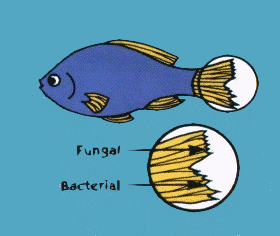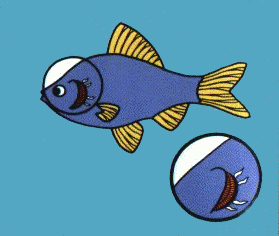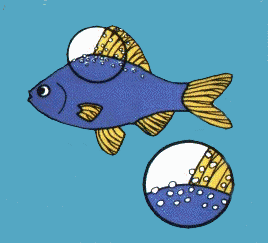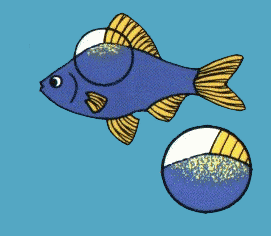
please update your bookmarks!
click banner for the new site and new sections
THIS PAGE IS ACTIVE BUT WILL NOT BE UPDATED, PLEASE GO TO THE MAIN SITE. YOU WILL BE AUTOMATICALLY TAKEN THERE IN 5 SECONDS

Diseases, Parasites and other Maladies
Prevention
This section will discuss ailments that affect the fish kept in our aquariums. I will simply not call them diseases because most are not true diseases but a response to some sort of stimuli such as poor tank water management or the presence of actual parasites. I will list the most common ailments, the reasons behind them and the appropriate action needed to "fix" the problem.
If you maintain good water quality, keep the right kind of fish together, feed good quality food and monitor all your water properties you will rarely have any problems. A few common sense precautions when you purchase new fish can save you a lot of trouble.
A few things to observe:
All of these and more should be closely looked at before you buy any fish and never buy a fish that does not look or act right and "cure" it at home! One last important thing, check out the stores filtration system. If the system is a central one be sure to check out all the tanks for signs of parasites as many are free swimming at some point in their lives, and they could move freely from tank to tank.
Once you decide to purchase the fish a few more precautions should be taken in order to keep risk at a minimum.
These are basic common sense guidelines that can save
you fish, plants and money if properly followed.

Diseases and other Ailments.
Ammonia Poisoning
Cause.
If too much organic waste is present and the load becomes
to much for the bacteria to handle the ammonia concentration in the tank will rise. If the pH is above seven ammonium turns into deadly ammonia and poisoning takes place.
Symptoms
The gills of the fish turn a lilac color and they hang sluggishly just below the water surface panting.
Treatment
Find the cause of the organic waste and remove, do a large
water change and slowly bring the the pH down below seven
if required.
Carbon Dioxide Poisoning
Causes
Too much CO2 fertilization.
Symptoms
Apathy, restless swimming and panting.
Treatment
Strong aeration, water change and never fertilize with co2
at night.
Nitrite / Nitrate Poisoning.
Causes
Heavy organic load or pollution and not doing enough water
changes. Also check water supply, some are high in Nitrates
to begin with.
Symptoms
Colors of the fish become more intense or really bright, panting, and hanging just below the water surface.
Treatment
Find cause of organic pollution and change water to bring down levels.
Poisoning from Tap Water
Causes
Tap water varies from area to area and may contain Chlorine, Copper, fertilizer and other pollutants.
Treatment
Test the water before using and filter with something like the
Tap Water Purifier or use water run thru an reverse osmosis
filter.
Bacterial Fin Rot

Dropsy
Cause
Bacteria.
Symptoms
Fish is bloated with scales standing out edgewise.
Treatment
Causes Kidney damage, treat with a medication for internal infections.
Hexamita or hole in the head disease
Cause
Parasitic, Hexamita is a single cell parasite that most often infects Discus, Oscars, Angelfish and The Gouramies.
Symptoms
Loss of appetite, uneven swimming, colors become more
intense and pin sized or larger holes appear in the head
region.
Treatment
Depends on the stage of the disease, early stages with only
small holes can be helped with the addition of vitamins.
Later stages can try a commercially available treatment. It
is usually fatal.
Gill and skin Flukes.

Ichthyophtirius or ICK

Velvet

Pop-eye
Cause
Unknown, but possibly fish tuberculosis, bacterial infection
or even over saturation of dissolved oxygen.
Symptoms
Eye or Eyes protrude from their sockets.
Treatment
Difficult due to its unknown cause, general antibiotic.
Hemmorrhagic Septiicemia

It is better to medicate fish in a separate tank with a bare bottom. Treating an entire aquarium can affect the biological bed and result in high ammonia and nitrite levels. Many medications will kill live plants and invertebrates, discolor silicone or be absorbed into the substrate making it very difficult to remove from the the system.
Always follow the manufacturers directions. Using too low of a dose will not be effective and too high of a dose can cause respiratory and other problems. Be sure to repeat the treatments if the directions call for it.
Never mix medications in the same tank unless the directions say its okay to do so.
Remove carbon, resins and all absobative filter medias, turn off protein skimmers, ozonizers and U.V. sterilizers. These materials will remove the medication before it has a chance to work.
If nothing cures your fish it may be better to "put it out of its misery" do this as quickly and painlessly as possible by severing the spinal cord behind the head with a sharp knife or scissors. Large fish should be stunned first with a hard blow to the head. (sorry for this, but sometimes it is needed )

|
|
